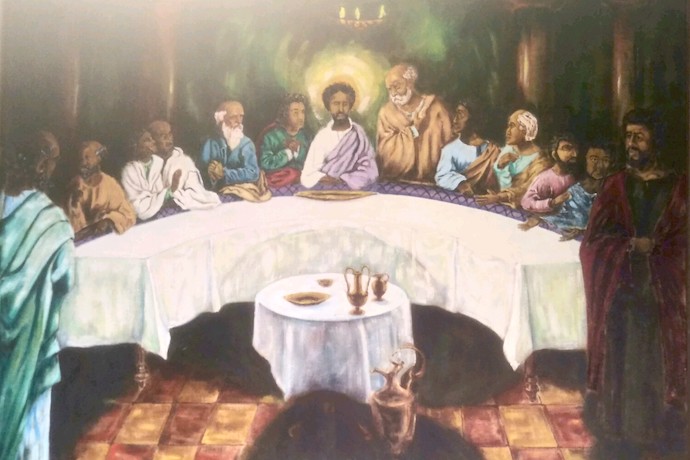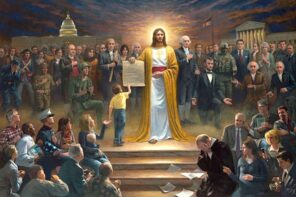As a child growing up in Louisville, Kentucky in the late 1970s a curious painting hung in my family’s den depicting thirteen men of varying shades of brown sitting around a long table partaking in a meal. In the middle was a brown-skinned man sitting stoically with a halo surrounding his perfectly round Afro. I know you’re thinking the very same thing I did when I was a kid: “You had a picture of Richard Pryor and his friends hanging up in your house?”
It would be several years before I realized that my father had painted this rendition of the Last Supper and that he’d consciously decided to paint Jesus and the Twelve Disciples as Black. From an early age I’d been bombarded by pictures in illustrated Bibles, children’s Sunday school books, television and movies, implying that Jesus was white, so it made perfect sense to me that the man depicted in the painting was one of the most popular Black men I knew of at the time, Richard Pryor.
This memory surfaced last week when I heard that writer and activist Shaun King had drawn a great deal of attention by calling for the tearing down of all statues of white Jesus, as they represented a form of white supremacy. King tweeted,
Yes, I think the statues of the white European they claim is Jesus should also come down. They are a form of white supremacy. Always have been. In the Bible, when the family of Jesus wanted to hide, and blend in [emphasis mine], guess where they went? EGYPT! Not Denmark. Tear them down.
https://twitter.com/shaunking/status/1275113067555303424
King received harsh criticism for his stance, largely from conservative Christians, but his point regarding the impact of portraying Jesus as a white man in contemporary America does require us to grapple with the history of white supremacy and how the image of “white Jesus” functions as a tool of racial subjugation. The continued depiction of Jesus as a “white male” of Western European heritage is problematic not only for historical reasons but also for explicit and implicit connections between conceptions of the divine and racial whiteness. For those reasons it would be wise, if not morally just, if Christians of all backgrounds began the important work of removing and replacing depictions of Jesus as a white man with more historically accurate representations—or with no representations at all.
King is by no means the first to articulate the belief that “white Jesus” represents a form of theological white supremacy. African Americans have been challenging the representation of Christ as white as far back as Bishop Henry McNeal Turner, the African Methodist Episcopal (AME) minister who stated in the sermon “God is a Negro,” that:
We have as much right biblically and otherwise to believe that God is a Negroe, as you buckra, or white people have to believe that God is a fine looking, symmetrical and ornamented white man. For the bulk of you, and all the fool Negroes of the country believe that God is white-skinned, blue eyed, straight-haired, projected nosed, compressed lipped and finely robed white gentleman sitting upon a throne somewhere in the heavens.
Turner, and later Malcolm X, along with other Black religious thinkers, are correct that African Americans have the right to represent God in their own image. However, after we’ve removed pictures of white Jesus, what are the theological issues that remain for those who’ve been impacted by centuries of explicit and implicit white supremacist theology? And how might internalized white theology still be present for African Americans and others even after white Jesus comes down and browner and blacker depictions become normalized within American society?
I argue that the removal of white Jesus as an icon doesn’t directly equate to the uplifting of Black humanity on theological grounds. The question of how Jesus should be depicted in racial terms is more complicated than representing the “right” color. The push to remove white Jesus and replace this representation with more historically accurate depictions partially obscures the need for African Americans to also reevaluate their own theological anthropology, (meaning the attempt to think about what it means to be human in connection with our understanding about the divine) which has long been coupled to Judeo-Christian centered notions of blackness.
In King’s rebuke of “white Jesus” he shares some commonly held beliefs about the blackness of the historical Jesus and what that means theologically, in particular to African Americans. King’s tweet referenced the “Flight into Egypt” (Matthew 2:13) when the holy family were called to flee to Egypt to avoid the “massacre of the innocents” by King Herod. This scriptural reference has served as a prooftext that Jesus and his family were going to hide amongst “Black” people in Africa away from the fury of an infanticidal despot, hence King’s emphasis on “EGYPT” not Denmark (Europe).
King is relying on a cultural trope in African-American religious history called Ethiopianism found throughout African-American Christianity, Black Judaism, Black Islam and Anglo-Caribbean religious traditions such as Rastafarianism, with the reference to the Biblical passage: “Princes shall come of Egypt; Ethiopia shall soon stretch out her hands unto God” (Psalms, 68:31). This verse was seen by some as a prophecy that Africa would experience a political, industrial, and economic renaissance after the “fall” of New World slavery.
The tradition of reading this reference to Egypt as a racial refuge for the young Christ child has long been understood by believers that African people have always been part of the story of human redemption in the Christian tradition. King’s tweet however represents deeper issues plaguing African Americans and their relationship to the Christian faith. Philosopher John H. McClendon III argues that African Americans have traditionally read the Bible as a historical text that holds significance for Black humanity which he calls the “Blackening of the Bible” and “Black Christology.”
Hence, for Black theologians and laypeople, “Blackening of the Bible” and “Black Christology” is reading the biblical text to affirm African-American humanity through identifying the positive representation of Africa and people of African descent that serves as theological anthropology. This means that African Americans have affixed their notion of what it means to be Black and a full human being in an anti-Black racist world, to their relationship to positive “Black” biblical personalities or God as Black, whether phenotypically (physical appearance) or ontologically (being). This is present in the ‘Black Christology’ of academic theologians such as James Cone, Albert Cleage, Jr., and within popular readings of the Bible by African Americans who identify with Jesus as a co-sufferer. Social media currently abounds with tweets, memes, and posts portraying Jesus as an unarmed man of color who was killed by Roman authorities or “law enforcement” by being “lynched” on a cross.
Although Shaun King and others are correct to call for the removal of white Jesus as historically inaccurate and racist, the racialization of Jesus as “Black” presents a theological issue which requires discussion. I argue that the racialization of Jesus as “Black” conflates the scholarly attempts to uncover the “historical Jesus” with the “Christ of faith.” The historical Jesus is the reconstruction of the life and teachings of Jesus based on a critical historical method which also considers the historical and cultural contexts in which Jesus lived. In other words this is the attempt to reconstruct the life of Jesus of Galilee as a living human being.
The “Christ of faith,” on the other hand, is a theological construction which is concerned with reconciling his humanity and divinity, and the relation between these two aspects and the role that plays in salvation. The Christ of faith is far less concerned with the minutiae of human life and culture including physical depictions. It could be argued that the Christ of faith is largely a matter of the spirit regardless of the physical body he inhabited.
In response to this conflation between the “historical Jesus” and the “Christ of faith” by Black Christology, McClendon raises the question:
“How do we determine whether Jesus is Black rather than white? Can it be historically confirmed that Jesus was a Black Messiah? Or is this Christological concept—Black Messiah—the product of faith commitments and theological construction?”
In other words if the cultural context that Jesus lived in was absent of blackness or whiteness as categories of being, how can we theologically assert that Jesus is Black, which is explicitly argued by Black Christology, or accept the implicit whiteness that exist throughout American Christainity as typified by Fox News contributor Megan Kelly’s infamous remark in 2013 that Jesus (along with Santa) was white?
In both cases, the racializing of Jesus seeks to attach an implicit sanctioning or explaining of one’s status in society. To quote the popular aphorism in the Black community, They talked about the Lord, what do you expect they gonna say about you?—meaning that Black suffering is understood within the context of co-suffering with Jesus. Stated plainly, African-American Christians must go beyond depicting Jesus as Black and move to conceptualizing what it means to be Black and fully human independent of how people of African descent may or may not have been presented in the Bible.
The inverse of racializing Jesus are the evasions by both whites and Blacks that Jesus’ color is largely trivial or unimportant; i.e. that “Jesus’ color doesn’t matter.” In his “Advice for Living” column for Ebony in 1957 Martin Luther King Jr. was asked, “Why did God make Jesus white, when the majority of peoples in the world are non-white?” To which King replied:
“The color of Jesus’ skin is of little or no consequence…The significance of Jesus lay, not in His color, but in His unique God-consciousness and His willingness to surrender His will to God’s will.”
Clearly Dr. King is trying to reassure readers that outward appearance is less important than moral character and the conviction to pursue justice. However, I’m afraid in this instance Dr. King misses the point in his appeal for racial universality. It is precisely because race matters in our society that depictions of Jesus as embodied divinity matter to American Christians.
Understanding this theological crisis for American Christians is paramount if we seek to address the deployment of “White Jesus” as an imposition of white supremacy in theological form.
In a follow up tweet Shaun King makes the declaration,
All murals and stained glass windows of white Jesus, and his European mother, and their white friends should also come down. They are a gross form white supremacy. Created as tools of oppression. Racist propaganda. They should all come down.
While color symbolism (particularly its black-white dichotomy) has long been a part of the Christian tradition, it wasn’t until the advent of modernity, with the appearance of racialized slavery in the Americas, that “white Jesus” signified racialized whiteness rather than a variation of the culturally specific and admittedly fictional depictions that appeared wherever Christianity spread.
It’s with the emergence of the concept of race, that “white Jesus” is truly born. Historian of American religion, Edward Blum traces the racialization of Jesus in the American context in The Color of Christ: The Son of God and the Saga of Race in America. Blum notes that questions and anxieties over the physical appearance of Christ have existed in America as far back as the colonial era with the Puritans banning images of Christ, God, or the Virgin Mary as a way to differentiate themselves from Catholics.
While not historically accurate, these depictions did not possess the racialized character that we’ve witnessed throughout the modern era. The transition from a culturally specific depiction of Jesus as white within Western Europe, to the emergence of Jesus as a “white god” occurred during the period of Native American dispossession, African enslavement, and later during the era of colonization of Africa and Asia.
The transformation of ancient and medieval color symbolism into racial discrimination and prejudice didn’t require graphic depictions of the divine, as David M. Goldenberg astutely argued in The Curse of Ham: Race and Slavery in Early Judaism, Christianity, and Islam. Goldenberg traces the racial discourses that emerged within Judaism, Christianity, and Islam as African enslavement increased within western Christendom and Dar-al Islam. This degradation of the African body as black and evil is directly correlated to the increase of Africans as coerced labor throughout the Middle East, Europe, and the Americas.
As we call for the removal and replacing of white Jesus, it must be recognized that the depiction of Jesus as white need not necessarily be present to have a white supremacist theology. If Christianity is still coupled to a white supremacist theology, it may remove the icons of Jesus as white while still performing the functions of white supremacy.
For example, consider the transition from Jim Crow segregation and discrimination to the era of color-blind racism that removed the physical signs of segregation but still pursued the outcomes of the former. Therefore for those who seek to expel white supremacy from American Christianity, the removal of white Jesus is only a first step, not the completion of the process. It will require continued wrestling with whiteness as a theological norm within American Christianity from seminary education all the way down to the mundane phrase “God Bless America.”
Therefore the solution to ferreting anti-black racism and white supremacy out of American Christianity is a more arduous task than just calling for the removal of white Jesus icons. Some Christians may refuse to part ways with their white god (even in the face of the most logical and current research on the historical Jesus), but the work of displacing whiteness as coterminous with divinity also means overturning the material conditions that led to its entrenchment in the first place.
Like the Confederate flag, white Jesus will be hard to remove from the American consciousness as long as white supremacy, in both its sacred and secular forms, are allowed to remain unchallenged. The challenge for white conservative Christians and others is, can they accept a historical Jesus that was a man of color; and through their worship of the “Christ of Faith” see the humanity of people that happen to look like him in the society they live in?
For my young nephews who gaze upon my father’s portrait of the Last Supper (which now adorns my sister’s dining room), their experience with Jesus as a man of color will be normalized and they won’t have to resort to questioning why they have a picture of Childish Gambino and his twelve friends having dinner hanging on the wall. The challenge, therefore, to those who wish to see Jesus as Black, is: can they also reject a theological anthropology rooted in white supremacy, which means that the color of Christ can neither validate nor negate Black humanity—even if their Messiah had “hair white like wool” and “feet like burnt brass”?





